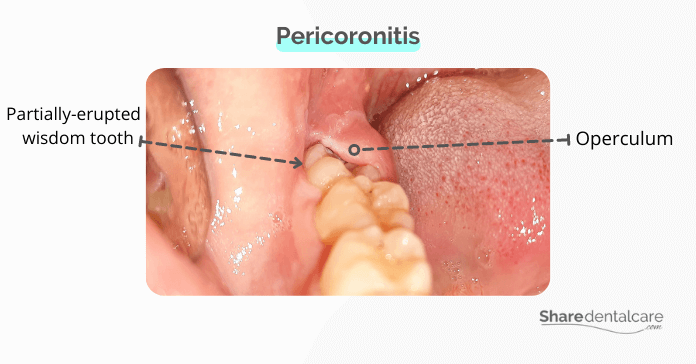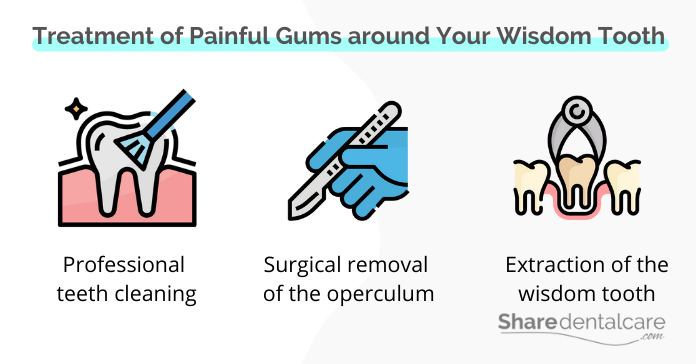Do you have painful gums around your wisdom tooth? You’re not alone. Many people experience this painful condition. The pain is usually caused by infection and inflammation. This can happen when food gets caught around the wisdom tooth and bacteria starts to grow. In this blog post, we will discuss the causes of painful gums around a wisdom tooth and what to do about it.
What Causes Painful Gums around a Wisdom Tooth?
As we mentioned, painful gums around a wisdom tooth usually occur as a result of infection and inflammation. Dental plaque is a sticky film of food debris, bacteria, and saliva that forms on teeth surfaces. If plaque is not removed, it can harden into brown tartar on teeth. Tartar can only be removed by a dentist or oral hygienist. When plaque and tartar build-up around the wisdom tooth, bacteria produce toxins that destroy the tooth and irritate the gums, leading to painful gums.
The following conditions may cause red, swollen, and painful gums:
- Pericoronitis: It is the infection and inflammation of the gum tissue flap (operculum) covering a partially erupted or impacted wisdom tooth.
- Gum disease: It is a bacterial infection of the gums that cause them to become red, swollen, and painful.
- Tooth decay and dental abscess: Bacteria destroy the tooth enamel and spread to the inner of the tooth (the dental pulp), causing an abscess, a painful pus-filled pocket that forms around the tooth.

Risk Factors
Several factors can increase the risk for painful gums, these include:
- Poor oral hygiene: If you don’t brush and floss regularly, food and bacteria can build up around your teeth, increasing the risk for an infection.
- Partially erupted or impacted wisdom teeth: If your wisdom teeth have not fully erupted or are impacted (stuck under the gum tissue), they are more difficult to clean and more likely to trap food and bacteria.
- Smoking: Tobacco smoking dries out the gum tissue and decreases blood flow to the gums, making them more susceptible to infection. You can read more about how can smoking cause periodontal disease.
- Dry mouth condition: Saliva helps to keep the mouth clean and free of bacteria. If you have a condition that decreases saliva production (such as Sjogren’s syndrome), you are at a higher risk for painful gums around a wisdom tooth.
- Diabetes: People with diabetes are more susceptible to gum infection.
- Hormonal changes: During puberty, pregnancy, and menopause, the gum tissue is more sensitive and can be more easily irritated.
- Certain medications: Certain medications cause dry mouth as a side effect, which can lead to painful gums around your wisdom tooth. Also, medications such as steroids and chemotherapy drugs can decrease the body’s ability to fight infection.
If you have any of these risk factors, it’s important to be extra diligent about oral hygiene and see your dentist regularly.

Symptoms
The painful gums around your wisdom tooth may appear in association with one or more of the following symptoms:
- Swelling and redness around the wisdom tooth
- Pain when chewing or biting
- Pus discharge
- Bad taste in the mouth
- Bad breath. You can read more about the unpleasant smell of pericoronitis.
- Difficulty opening the mouth (lockjaw) and jaw pain.
Visit your dentist if you experience any of these symptoms. The infection can spread to other parts of the body if it is not treated.
Home Remedies for Painful Gums around a Wisdom Tooth
There are several things you can do at home to ease painful gums around your wisdom tooth.
- Over-the-counter pain medications: ibuprofen (Advil) and acetaminophen (Tylenol) can help to ease pain and inflammation.
- Good oral hygiene: brush your teeth with a soft-bristled toothbrush to remove plaque and food particles. Be sure to brush around your wisdom tooth gently. Floss at least once a day to remove plaque from between your teeth.
- Salt water rinse: mix a half teaspoon of salt in a cup of warm water and swish it around your mouth for 30 seconds. Spit it out and repeat it a few times a day.
These home remedies can help to ease the pain and inflammation of gums around your wisdom tooth. However, they will not cure the underlying cause. Home remedies don’t replace professional treatment. So, it’s important to see your dentist as soon as possible.
You can read more about the pericoronitis home remedy.
How to Treat Painful Gums around Your Wisdom Tooth?
The treatment depends on the underlying cause and condition of the wisdom tooth. The treatment options for painful gums around your wisdom tooth include:
- Professional teeth cleaning: In the case of gum disease, your dentist may perform a professional cleaning to remove plaque, bacteria, and food debris. If your gum disease is severe, your dentist may recommend scaling and root planing, a deep cleaning procedure to remove severe plaque on teeth and tartar from below the gum line.
- Antibiotics: Your dentist may prescribe antibiotics to help clear the infection.
- Operculectomy: In the case of pericoronitis, your dentist may perform minor surgery to remove the flap of gum tissue (inflamed operculum) covering the impacted or partially erupted wisdom tooth.
- Tooth extraction: If your wisdom tooth is severely decayed or erupts at an odd angle, it may need to be extracted.
After the treatment, it’s important to practice good oral hygiene and see your dentist regularly to prevent the infection from coming back.

Conclusion
Painful gums around your wisdom tooth usually occur as a result of infection. When plaque builds up around a tooth, plaque bacteria produce toxins that cause the gums to become inflamed and painful. Several factors can increase your risk, including poor oral hygiene, smoking, and impacted wisdom teeth.
Home remedies can help ease the pain, but they don’t replace professional treatment. So, it’s important to see your dentist as soon as possible. The treatment will depend on the underlying cause and the condition of your wisdom tooth.